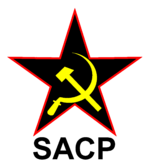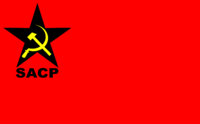South African Communist Party facts for kids
Quick facts for kids
South African Communist Party
|
|
|---|---|
 |
|
| Chairperson | Blade Nzimande |
| General Secretary | Solly Afrika Mapaila |
| First Deputy General Secretary | Madala Masuku |
| Second Deputy General Secretary | David Masondo |
| Founded | 12 February 1921 |
| Preceded by | International Socialist League |
| Headquarters | 4th Floor Cosatu House 110 Jorissen Street Johannesburg Gauteng |
| Newspaper | Umsebenzi |
| Youth wing | Young Communist League of South Africa |
| Membership (2015) | |
| Ideology | Communism Marxism–Leninism |
| Political position | Far-left |
| National affiliation | Tripartite Alliance |
| International affiliation | IMCWP |
| Regional affiliation | Africa Left Networking Forum |
| Colours |
|
| Party flag | |
 |
|
The South African Communist Party (SACP) is a political party in South Africa. It believes in communism, an idea where everyone is equal and resources are shared. The party was first started on 12 February 1921 as the Communist Party of South Africa (CPSA).
In 1950, the government made the party illegal. So, the party secretly ended itself for a short time. It then started again in 1953 as the SACP, working underground. The SACP played a big part in the fight to end apartheid, a system of unfair laws that separated people by race.
Today, the SACP is part of the ruling Tripartite Alliance. This is a partnership with the African National Congress (ANC) and the Congress of South African Trade Unions (COSATU). Through this alliance, the SACP helps influence the South African government. The party's main decision-making group is called the Central Committee. The SACP plans to run its own candidates in the 2026 local elections. This is a new step for the party.
Contents
History of the SACP
The Communist Party of South Africa began in 1921. It was formed when the International Socialist League and other groups joined together. William H. Andrews was one of its first leaders.
Early Years and Worker Rights
The party first became well-known during the Rand Rebellion in 1922. This was a big strike by white miners. Mining companies wanted to hire black workers for lower pay. White miners were worried about losing their jobs and high wages.
The CPSA supported the strike. They saw it as a fight between workers and rich business owners. However, the party did not agree with the racist ideas linked to the strike. They stated that all workers, no matter their race, needed to unite. Their goal was to fight for a fair South Africa and better conditions for everyone.
After this, the party decided to focus on organizing black workers. By 1928, most of its members were black. Around this time, an international communist group suggested that South Africa belonged to its native black population. This idea was called the "Native Republic" thesis. The CPSA later stopped supporting this idea by 1948.
In 1946, the CPSA joined the African National Congress (ANC) in a big strike. This strike was started by African mine workers. Many party members, like Bram Fischer, were arrested during this time.
Fighting Against Apartheid
The National Party came to power in 1948. They planned to ban the Communist Party. Because of this, the CPSA decided to dissolve itself. Some members wanted to continue working secretly. But most felt it was better to support the ANC in their fight for fair rule.
After it dissolved, the CPSA was officially banned in 1950. In 1953, former CPSA members started the South African Communist Party (SACP). This new party continued to work secretly. The SACP was a main target of the National Party. The Suppression of Communism Act, 1950 was used to stop anyone who wanted to end apartheid.
After the ban, SACP members worked within the ANC. They helped change the ANC's goals to include all ethnic groups in South Africa. White SACP members formed the South African Congress of Democrats. This group joined with the ANC and others to form the Congress Alliance. This alliance worked for a democratic and non-racial South Africa.
The Freedom Charter was a very important document for this alliance. It outlined a vision for a free and fair South Africa. The SACP helped create this charter. It became the main plan for the alliance to achieve a democratic South Africa.
As the National Party became stricter, the ANC decided to use armed resistance. Leaders like Nelson Mandela and Walter Sisulu knew the ANC would be banned. They teamed up with communists to form Umkhonto we Sizwe ("Spear of the Nation"). This group began to use armed resistance against the government. Many leaders were arrested and jailed. Joe Slovo, a communist, was a key leader of Umkhonto.
While in exile, communist countries helped the ANC with money and weapons. The ANC slowly grew stronger inside South Africa. They gained support from young South Africans after the Soweto uprising in 1976.
Eventually, pressure from outside South Africa and protests inside led to change. Negotiations began, and in 1994, the National Party was defeated. This ended forty-six years of their rule.
After Apartheid
After the victory, many communists held important positions in the new government. Nelson Mandela even appointed Joe Slovo as Minister for Housing. This time also brought new challenges for the ANC-SACP alliance. The ANC's plans did not aim to completely change South Africa's economic system. They relied on foreign investment and tourism.
In his book Long Walk to Freedom, Nelson Mandela wrote about the alliance. He said: "The cynical have always suggested that the Communists were using us. But who is to say that we were not using them?" After Mandela passed away in 2013, the ANC confirmed he had been a member of the SACP. He also served on its central committee.
On July 30, 2011, the SACP celebrated its 90th anniversary.
The SACP has had a lot of influence within the ANC. Many SACP members are part of the ANC's National Executive Committee. The SACP often disagreed with the policies of President Thabo Mbeki (1999–2008). This was clear when Mbeki was replaced by Jacob Zuma. Zuma was seen as more open to the ideas of the SACP and COSATU.
For a long time, the SACP did not run in elections under its own name. However, in December 2017, the party ran in some local elections. They did not win many seats directly but gained some proportional representation seats. In total, the SACP received 3,270 votes (6.3%) in those elections.
In December 2024, the party decided to run in local elections under its own name. This included the upcoming 2026 South African municipal elections. In July 2025, the party received 1% of the vote in its first election after this decision. They finished third in a local ward election in Polokwane.
General Secretaries
- 1921: William H. Andrews
- 1925: Jimmy Shields
- 1929: Douglas Wolton
- 1929: Albert Nzula
- 1932: J. B. Marks
- 1933: Moses Kotane
- 1936: Edwin Thabo Mofutsanyana
- 1938: Moses Kotane
- 1978: Moses Mabhida
- 1984: Joe Slovo
- 1991: Chris Hani
- 1993: Charles Nqakula
- 1998: Blade Nzimande
- 2022: Solly Afrika Mapaila
National Chairpersons
- 1921: William H. Andrews
- 1925: Sidney Bunting
- 1931: Douglas Wolton
- 1933: Lazar Bach
- 1935: Issie Wolfson
- 1939: William H. Andrews
- 1953: Bram Fischer
- 2007: Gwede Mantashe
- 2017: Senzeni Zokwana
- 2022: Blade Nzimande
Important Members of the SACP Central Committee
- Michael Harmel
- Moses Kotane
- J. B. Marks
- Bram Fischer
- Jeremy Cronin
- Ruth First
- Chris Hani
- Ronnie Kasrils
- Mac Maharaj
- Nelson Mandela
- Govan Mbeki
- Thabo Mbeki
- Raymond Mhlaba
- Joe Slovo
- Yusuf Dadoo
- Blade Nzimande
- Sechaba "Charles" Setsubi
- Rob Davies
- George Mashamba
- Mfengu Makhalima
- Brian Bunting
- Kay Moonsamy
- John Nkadimeng
- Esther Barsel
- Charles Nqakula
- Judy Malqueeny
- Thenjiwe Mtintso
- John Gomomo
Veterans of the SACP
- Sydney Mufamadi
- Charles Nqakula
- Essop Pahad
- David Niddrie
- David Ivon Jones - a founding member of the South African Communist Party
See also
 In Spanish: Partido Comunista Sudafricano para niños
In Spanish: Partido Comunista Sudafricano para niños
- List of communist parties
- African Communist
- Central Committee of the South African Communist Party
Literature
- Raising the Red Flag. The International Socialist League & the Communist Party of South Africa 1914 - 1932 by Sheridan Johns.
- Time Longer Than Rope by Edward Roux.

